JENN-AIR JGS8750ADB, JGS8750ADS, JGS8750ADW, JGS8850ADB, JGS8850ADQ Owner's Manual
...
JENN-AIR GAS SLIDE-IN RANGE
USER
G U I D E
TABLE OF CONTENTS |
|
Safety Instructions ................................................................... |
1-4 |
Surface Cooking ....................................................................... |
5-6 |
Oven Cooking ........................................................................ |
7-15 |
Care & Cleaning .................................................................. |
15-17 |
Maintenance ......................................................................... |
17-18 |
Before You Call for Service ................................................... |
19 |
Warranty .................................................................................... |
21 |
Guide de l’utilisateur................................................................ |
22 |
Guía del Usuario ....................................................................... |
43 |
Form No. B/07/02 Part No. 8113P368-60 74005525 © 2002 Maytag Appliances Sales Co. Litho U.S.A .
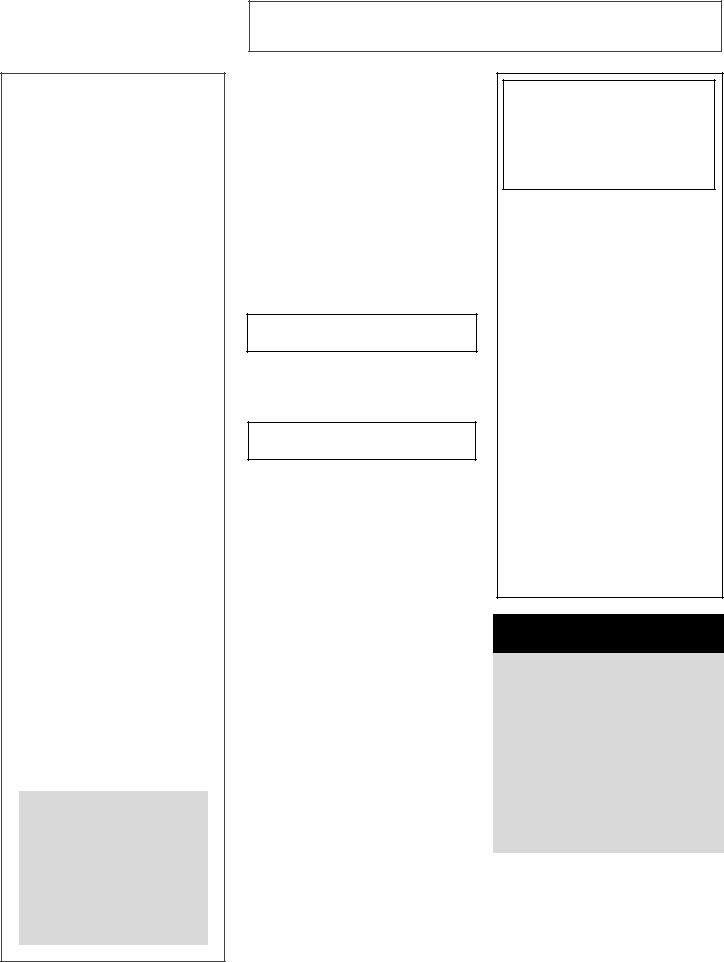
Installer: Please leave this manual with this appliance.
Consumer: Please read and keep this manual for future reference. Keep sales receipt and/or cancelled check as proof of purchase.
Model Number
–– –– –– –– –– –– –– –– ––
Serial Number
–– –– –– –– –– –– –– –– ––
Date of Purchase
_______________________________
If you have questions, call:
Jenn-Air Customer Assistance
1-800-688-1100
1-800-688-2080 ( U.S. TTY for hearing or speech impaired)
(Mon.-Fri., 8 am-8 pm Eastern Time)
Internet: http://www.jennair.com
For service information, see page 21.
In our continuing effort to improve the quality and performance of our cooking products, it may be necessary to make changes to the appliance without revising this guide.
IMPORTANT SAFETY INSTRUCTIONS
SAFETY INSTRUCTIONS
Warning and Important Safety Instructions appearing in this guide are not meant to cover all possible conditions and situations that may occur. Common sense, caution, and care must be exercised when installing, maintaining, or operating the appliance.
Always contact your dealer, distributor, service agent, or manufacturer about problems or conditions you do not understand.
RECOGNIZE SAFETY SYMBOLS, WORDS, LABELS
 WARNING
WARNING
WARNING – Hazards or unsafe practices which COULD result in severe personal injury or death.
 CAUTION
CAUTION
CAUTION – Hazards or unsafe practices which COULD result in minor personal injury.
Read and follow all instructions before using this appliance to prevent the potential risk of fire, electric shock, personal injury or damage to the appliance as a result of improper usage of the appliance. Use appliance only for its intended purpose as described in this guide.
To ensure proper and safe operation:
Appliance must be properly installed and grounded by a qualified technician. Do not attempt to adjust, repair, service, or replace any part of your appliance unless it is specifically recommended in this guide. All other servicing should be referred to a qualified servicer. Have the installer show you the location of the gas shut off valve and how to shut it off in an emergency.
Always disconnect power to appliance before servicing.
 WARNING: If the information in this manual is not followed exactly, a fire or explosion may result causing property damage,personalinjuryordeath.
WARNING: If the information in this manual is not followed exactly, a fire or explosion may result causing property damage,personalinjuryordeath.
–Do not store or use gasoline or other flammable vapors and liquids in the vicinity of this or any appliance.
–IF YOU SMELL GAS:
•Do not try to light any appliance.
•Do not touch any electrical switch.
•Do not use any phone in your building.
•Immediately call your gas supplier from a neighbor’s phone. Follow the gas supplier’s instructions.
•If you cannot reach your gas supplier, call the fire department.
–Installation and service must be performed by a qualified installer, service agency or the gas supplier.
 WARNING
WARNING
Because gas may escape from your system which may not be detected by smell alone, resulting in a potentially extremely dangerous situation, it is recommended by gas suppliers that you purchase and install a UL approved gas detector(s) in your home. Your local gas supplier can assist you in obtaining a gas detector. Please install, maintain and use the gas detector in accordance with the gas detector manufacturer’s instructions.
1
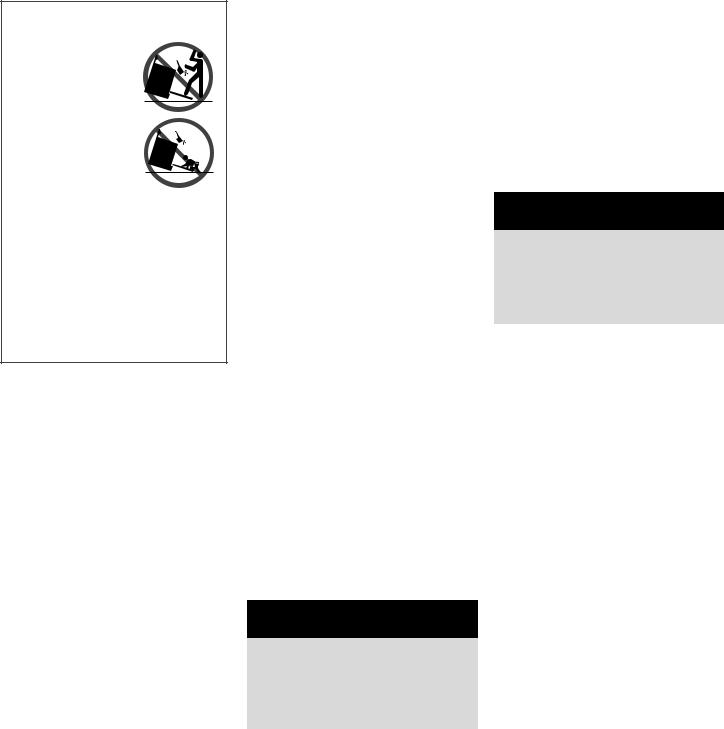
GENERAL
INSTRUCTIONS
 WARNING:
WARNING:
• ALL RANGES CAN TIP AND CAUSE INJURIES TO PERSONS
• INSTALL ANTITIP DEVICE PACKED WITH RANGE
•FOLLOW ALL INSTALLATION INSTRUCTIONS
WARNING: To reduce risk of tipping of the appliance from abnormal usage or by excessive loading of the oven door, the appliance must be secured by a properlyinstalledanti-tipdevice.
To check if device is properly installed, remove storage drawer and look underneath range to make sure one of the rear leveling legs is properly engaged in the bracket slot. The anti-tip device secures the rear leveling leg to the floor when properly engaged. You should check this anytime the range has been moved.
TO PREVENT FIRE OR SMOKE DAMAGE
Be sure all packing materials are removed from the appliance before operating it.
Keep area around appliance clear and free from combustible materials, gasoline, and other flammable vapors and materials.
If appliance is installed near a window, proper precautions should be taken to prevent curtains from blowing over burners.
NEVER leave any items on the cooktop. The hot air from the vent may ignite flammable items and may increase pressure in closed containers which may cause them to burst.
Many aerosol-type spray cans are EXPLOSIVE when exposed to heat and may be highly flammable. Avoid their use or storage near an appliance.
Many plastics are vulnerable to heat. Keep plastics away from parts of the appliance that may become warm or hot. Do not leave plastic items on the cooktop as they may melt or soften if left too close to the vent or a lighted surface burner.
To eliminate the hazard of reaching over hot surface burners, cabinet storage should not be provided directly above a unit. If storage is provided, it should be limited to items which are used infrequently and which are safely stored in an area subjected to heat from an appliance. Temperatures may be unsafe for some items, such as volatile liquids, cleaners or aerosol sprays.
IN CASE OF FIRE
Turn off appliance and ventilating hood to avoid spreading the flame. Extinguish flame then turn on hood to remove smoke and odor.
•Cooktop: Smother fire or flame in a pan with a lid or cookie sheet.
NEVER pick up or move a flaming pan.
•Oven: Smother fire or flame by closing the oven door.
Do not use water on grease fires. Use baking soda, a dry chemical or foam-type extinguisher to smother fire or flame.
CHILD SAFETY
 CAUTION
CAUTION
NEVER store items of interest to children in cabinets above an appliance or on backguard of a range. Children climbing on the appliance door to reach items could be seriously injured.
NEVER leave children alone or unsupervised near the appliance when it is in use or is still hot.
NEVER allow children to sit or stand on any part of the appliance as they could be injured or burned.
Children must be taught that the appliance and utensils in it can be hot. Let hot utensils cool in a safe place, out of reach of small children. Children should be taught that an appliance is not a toy. Children should not be allowed to play with controls or other parts of the unit.
ABOUT YOUR
APPLIANCE
 WARNING
WARNING
NEVER use appliance door, or drawer, if equipped, as a step stool or seat as this may result in possible tipping of the appliance, damage to the appliance, and serious injuries.
NEVER use appliance as a space heater to heat or warm a room to prevent potential hazard to the user and damage to the appliance. Also, do not use the cooktop or oven as a storage area for food or cooking utensils.
Do not obstruct the flow of combustion and ventilation air by blocking the oven vent or air intakes. Restriction of air flow to the burner prevents proper performance and increases carbon monoxide emission to unsafe levels.
Avoid touching oven vent area while oven is on and for several minutes after oven is turned off. Some parts of the vent and surrounding area become hot enough to cause burns. After oven is turned off, do not touch the oven vent or surrounding areas until they have had sufficient time to cool.
Other potentially hot surfaces include cooktop, areas facing the cooktop, oven vent, surfaces near the vent opening, oven door, areas around the oven door and oven window.
Do not touch a hot oven light bulb with a damp cloth as the bulb could break. Should
2

IMPORTANT SAFETY INSTRUCTIONS, CONT.
the bulb break, disconnect power to the appliance before removing bulb to avoid electrical shock.
COOKING SAFETY
Always place a pan on a surface burner before turning it on. Be sure you know which knob controls which surface burner. Make sure the correct burner is turned on and that the burner has ignited. When cooking is completed, turn burner off before removing pan to prevent exposure to burner flame.
Always adjust surface burner flame so that it does not extend beyond the bottom edge of the pan. An excessive flame is hazardous, wastes energy and may damage the appliance, pan or cabinets above the appliance.
NEVER leave a surface cooking operation unattended especially when using a high heat setting or when deep fat frying. Boilovers cause smoking and greasy spillovers may ignite. Clean up greasy spills as soon as possible. Do not use high heat for extended cooking operations.
NEVER heat an unopened container on the surface burner or in the oven. Pressure build-up may cause the container to burst resulting in serious personal injury or damage to the appliance.
Use dry, sturdy potholders. Damp potholders may cause burns from steam. Dishtowels orothersubstitutesshouldnever be used as potholders because they can trail across hot surface burners and ignite or get caught on appliance parts.
Always let quantities of hot fat used for deep fat frying cool before attempting to move or handle.
Do not let cooking grease or other flammable materials accumulate in or near the appliance, hood or vent fan. Clean hood frequently to prevent grease from accumulating on hood or filter. When flaming foods under the hood turn the fan on.
NEVER wear garments made of flammable material or loose fitting or long-sleeved apparel while cooking. Clothing may ignite or catch utensil handles.
Always place oven racks in the desired positions while oven is cool. Slide oven rack out to add or remove food, using dry, sturdy potholders. Always avoid reaching into the oven to add or remove food. If a rack must be moved while hot, use a dry potholder. Always turn the oven off at the end of cooking.
Use care when opening the oven door. Let hot air or steam escape before moving or replacing food.
PREPARED FOOD WARNING: Follow food manufacturer’s instructions. If a plastic frozen food container and/or its cover distorts, warps, or is otherwise damaged during cooking, immediately discard the food and its container. The food could be contaminated.
NEVER use aluminum foil to cover oven racks or oven bottom. This could result in risk of electric shock, fire, or damage to the appliance. Use foil only as directed in this guide.
UTENSIL SAFETY
Use pans with flat bottoms and handles that are easily grasped and stay cool. Avoid using unstable, warped, easily tipped or loosehandled pans. Also avoid using pans, especially small pans, with heavy handles as they could be unstable and easily tip. Pans that are heavy to move when filled with food may also be hazardous.
Be sure utensil is large enough to properly contain food and avoid boilovers. Pan size is particularly important in deep fat frying. Be sure pan will accommodate the volume of food that is to be added as well as the bubble action of fat.
To minimize burns, ignition of flammable materials and spillage due to unintentional contact with the utensil, do not extend handles over adjacent surface burners. Always turn pan handles toward the side or back of the appliance, not out into the room where they are easily hit or reached by small children.
Never let a pan boil dry as this could damage the utensil and the appliance.
Follow the manufacturer’s directions when using oven cooking bags.
Only certain types of glass, glass/ceramic, ceramic or glazed utensils are suitable for cooktop or oven usage without breaking due to the sudden change in temperature. Follow manufacturer’s instructions when using glass.
This appliance has been tested for safe performance using conventional cookware. Do not use any devices or accessories that are not specifically recommended in this guide. Do not use eyelid covers for the surface units, stovetop grills, or add-on oven convection systems. The use of devices or accessories that are not expressly recommended in this manual can create serious safety hazards, result in performance problems, and reduce the life of the components of the appliance.
CLEANING SAFETY
Turn off all controls and wait for appliance parts to cool before touching or cleaning them. Do not touch the burner grates or surrounding areas until they have had sufficient time to cool.
Clean appliance with caution. Use care to avoid steam burns if a wet sponge or cloth is used to wipe spills on a hot surface. Some cleaners can produce noxious fumes if applied to a hot surface.
SELF-CLEAN OVEN
Clean only parts listed in this guide. Do not clean door gasket. The door gasket is essential for a good seal. Care should be taken not to rub, damage, or move the gasket. Do not use oven cleaners of any kind in or around any part of the self-clean oven.
Before self-cleaning the oven, remove broiler pan, oven racks and other utensils and wipe up excessive spillovers to prevent excessivesmoke,flare-upsorflaming.CAU- TION: Do not leave food or cooking utensils, etc. in the oven during the selfclean cycle.
Slide-in ranges feature a cooling fan which operates automatically during a clean cycle. If the fan does not turn on, cancel the clean operation and contact an authorized servicer.
3
It is normal for the cooktop of the range to become hot during a self-clean cycle. Therefore, touching the cooktop during a clean cycle should be avoided.
IMPORTANT SAFETY NOTICE AND WARNING
The California Safe Drinking Water and Toxic Enforcement Act of 1986 (Proposition 65) requires the Governor of California to publish a list of substances known to the State of California to cause cancer or reproductive harm, and requires businesses
to warn customers of potential exposures to such substances.
Users of this appliance are hereby warned that the burning of gas can result in lowlevel exposure to some of the listed substances, including benzene, formaldehyde and soot, due primarily to the incomplete combustion of natural gas or liquid petroleum (LP) fuels. Properly adjusted burners will minimize incomplete combustion. Exposure to these substances can also be minimized by properly venting the burners to the outdoors.
IMPORTANTNOTICEREGARDING PET BIRDS: Never keep pet birds in the kitchen or in rooms where the fumes from the kitchen could reach. Birds have a very sensitive respiratory system. Fumes released during an oven self-cleaning cycle may be harmful or fatal to birds. Fumes released due to overheated cooking oil, fat, margarine and overheated non-stick cookware may be equally harmful.
SAVE THESE INSTRUCTIONS FOR FUTURE REFERENCE
4
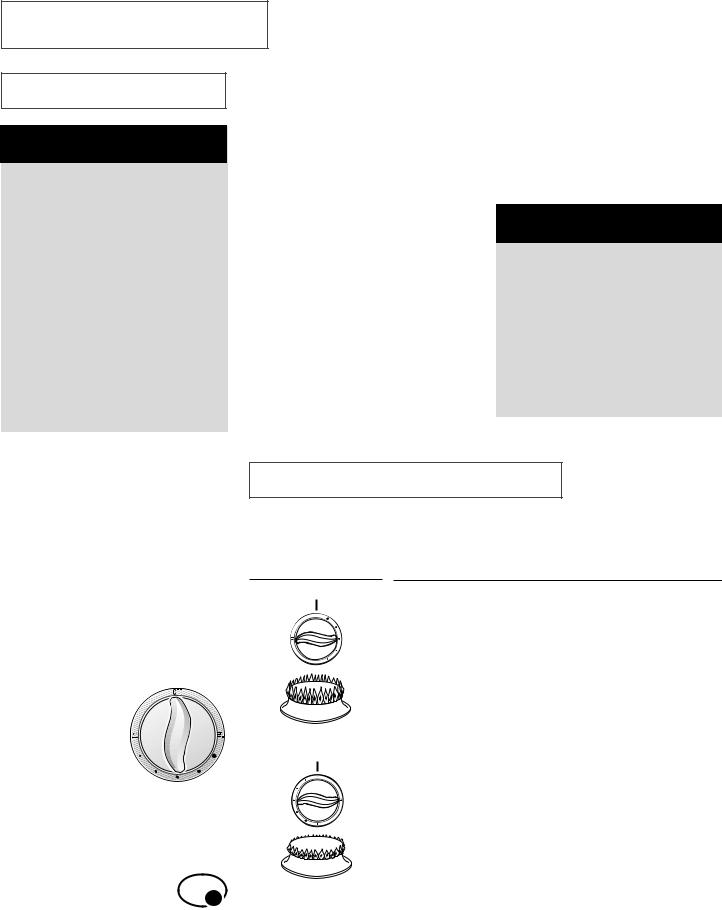
SURFACE COOKING
SURFACE CONTROLS
 CAUTION
CAUTION
•If flame should go out during a cooking operation, turn the burner off. If a strong gas odor is detected, open a window and wait five minutes before relighting the burner.
•Be sure all surface controls are set in the OFF position prior to supplying gas to the range.
•NEVER touch cooktop until it has cooled. Expect some parts of the cooktop, especially around the burners, to become warm or hot during cooking. Use potholders to protect hands.
SETTING THE CONTROLS
Your cooktop has sealed gas burners with automatic re-ignition. If the burner flame should go out, the system will automatically spark to re-ignite the burner.
1.Place a pan on the burner grate. (To preserve the grate finish, do not operate the burners without a pan on the grate to absorb the heat from the burner flame.)
2.Push in knob and turn immediately counterclockwise to the desired setting.
•A clicking (spark) sound will be heard and the burner will light. (All four ignitors will spark when any surface burner knob is turned on. However, only the selected burner will light.)
OPERATING DURING A
POWER FAILURE
1.Hold a lighted match to the desired surface burner head.
2.Push in and turn the control knob slowly to desired setting.
 CAUTION
CAUTION
•When lighting the surface burners, be sure all of the controls are in the OFF position. Strike the match first and hold it in position before turning the knob.
•Do not leave the cooktop unattended when cooking during a power failure. The automatic re-ignition feature will not operate during a power failure.
PILOTLESS IGNITION
Your range is equipped with pilotless ignition. With this type of ignition system, the gas automatically shuts off and the oven will not operate during a power failure.
A lighted match will not light the oven burner. No attempt should be made to operate the oven during a power failure.
SURFACE CONTROL KNOBS
Use to turn on the surface burners. An
infinite choice of heat settings is available
from lo to hi. At the
hi setting a detent or
notch may be felt. The knobs can be set on or between any of the settings.
Graphics next to the knob identify which burner the knob controls. For example, the graphic at right shows the right
front burner location.
SUGGESTED HEAT SETTINGS
The size and type of cookware will affect the heat setting. For information on cookware and other factors affecting heat settings, refer to “Cooking Made Simple” booklet.
Settings |
Uses |
hi |
Use hi to bring liquid to a boil, or reach pressure in a |
|
pressure cooker. Always reduce setting to a lower heat when |
|
liquids begin to boil or foods begin to cook. |
|
An intermediate flame size is used to continue cooking. Food |
|
will not cook any faster when a higher flame setting is used |
|
than needed to maintain a gentle boil. Water boils at the same |
|
temperature whether boiling gently or vigorously. |
lo |
|
|
Use lo to simmer foods, keep foods warm and melt |
|
chocolate or butter. |
|
Some cooking may take place on the lo setting if the pan is |
|
covered. It is possible to reduce the heat by rotating the knob |
|
toward OFF. Be sure flame is stable. |
5
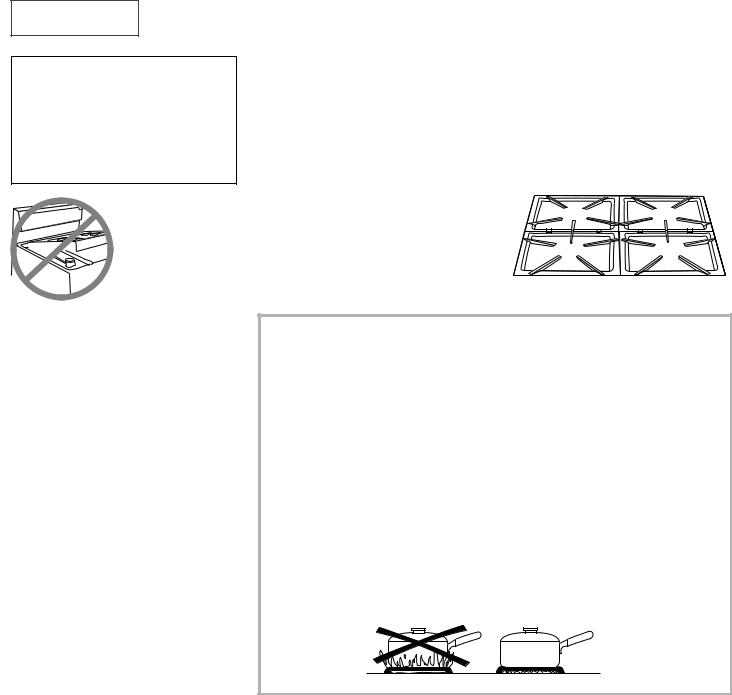
COOKTOP
To prevent the cooktop from discoloring or staining:
•Clean cooktop after each use.
•Wipe acidic or sugary spills as soon as the cooktop has cooled as these spills may discolor the porcelain.
Unlike a range with stan-  dard gas burners, this
dard gas burners, this  cooktop does not lift-
cooktop does not lift- 
 up nor is it removable.
up nor is it removable.
 Do not attempt to lift the cooktop for any
Do not attempt to lift the cooktop for any
reason.
SIMMER BURNER
This burner is located in the left front position. The simmer burner offers a lower BTU flame for delicate sauces or melting chocolate.
* BTU ratings will vary when using LP gas.
BURNER GRATES
The grates must be properly positioned before cooking. Improper installation of the grates may result in chipping of the cooktop.
Do not operate the burners without a pan on the grate. The grate’s porcelain finish may chip without a pan to absorb the heat from the burner flame.
Although the burner grates are durable, they will gradually lose their shine and/or discolor, due to the high temperatures of the gas flame.
SEALED BURNERS
The sealed burners of your range are secured to the cooktop and are not designed to be removed. Since the burners are sealed into the cooktop, boilovers or spills will not seep underneath the cooktop.
However, the burner heads should be cleaned after each use. The head portion of the burner is easily removed for cleaning. (See page 16 for cleaning directions.)
HIGH PERFORMANCE
BURNER (12,000 BTU*)
There is one high speed burner on your range, located in the right front position. This burner offers higher speed cooking that can be used to quickly bring water to a boil and for large-quantity cooking.
NOTES:
•A properly adjusted burner with clean ports will light within a few seconds. If using natural gas, the flame will be blue with a deeper blue inner cone.
If the burner flame is yellow or is noisy, the air/gas mixture may be incorrect. Contact a service technician to adjust. (Adjustments are not covered by the warranty.)
With LP gas, some yellow tips on the flames are acceptable. This is normal and adjustment is not necessary.
•With some types of gas, you may hear a “popping” sound when the surface burner is turned off. This is a normal operating sound of the burner.
•If the control knob is turned very quickly from hi to lo, the flame may go out, particularly if the burner is cold. If this occurs, turn the knob to the OFF position, wait several seconds and relight the burner.
•The flame should be adjusted so it does not extend beyond the edge of the pan.
6
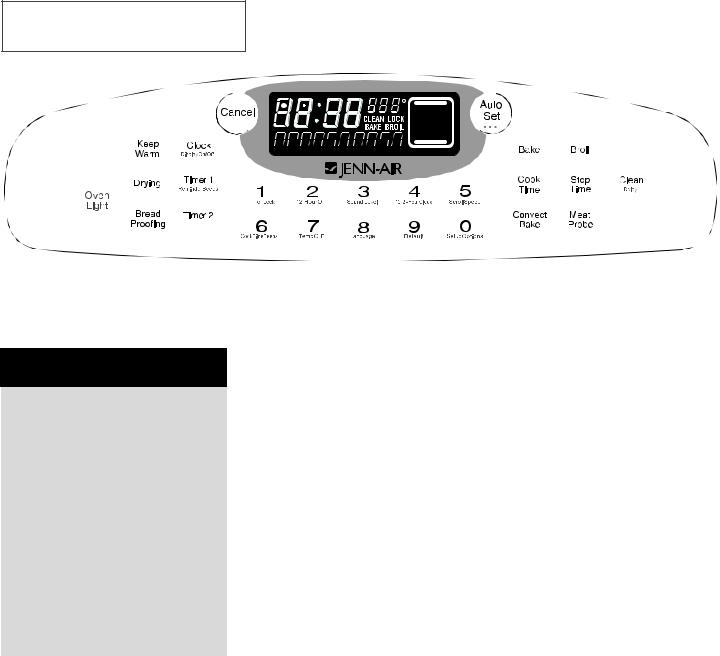
OVEN COOKING

 l
l
The electronic control is designed for ease in programming. The display window on the control shows time of day, timer and oven functions. Control panel shown includes Convect and other model specific features. (Styling may vary depending on model.)
 CAUTION
CAUTION
•Be sure all packing material is removed from oven before turning on.
•Prepared Food Warning: Follow food manufacturer’s instructions. If a plastic frozen food container and/or its cover distorts, warps, or is otherwise damaged during cooking, immediately discard the food and its container. The food could be contaminated.
•Follow the manufacturer’s directions when using oven cooking bags.
•Do not use oven for storing food or cookware.
CONTROL PAD
OPERATION
•Press the desired function pad.
•Press the Auto Set pad or the appropriate number pad(s) to enter time or temperature.
•A beep will sound when any pad is pressed.
•A double beep will sound if a programming error occurs.
•Further instructions will scroll in display after function pads are pressed.
NOTE: The temperature or time will be automatically entered four seconds after selection.
If more than 30 seconds elapse between pressing a function pad and the Auto Set pad or number pads, the function will be canceled and the display will return to the previous display.
CONTROL OPTIONS
Several control options are indicated under the number pads on the control. Factoryset options can be changed to your preferences. See page 13 for more information.
SETTING CONTROL
FUNCTIONS
CLOCK PAD
1.Press Clock pad. Indicator word TIME will flash in the display.
2.Press the appropriate number pads for the current time.
After a power interruption, POWER INTERRUPTION will scroll followed by SET CLOCK.
To recall the time of day when another function is showing, press Clock pad.
Clock time cannot be changed when the oven has been programmed for clock controlled cooking, self-clean or delayed selfclean.
The clock may be set to a 24-hour clock. See Control Options (12/24 Hour Clock), page 13.
TIMER PADS
The timer(s) may be set for any time period up to 99 hours and 59 minutes (99:59).
The timer(s) operates independently of any other function and can be set while another oven function is operating. THE TIMER
DOES NOT CONTROL THE OVEN.
1.Press the Timer 1 or 2 pad. TIMER 1 or 2 will flash respectively. 0HR:00 will appear in the display.
2.Press the appropriate number pads to enter desired time.
3.TIMER 1 or TIMER 2 will be displayed. If both timers are active, the Timer with the least amount of time left will be displayed.
EXAMPLE: To set a timer for 5 minutes, press the Timer 1 pad and the number pad 5. The control will begin countdown after a four second delay.
4.The last minute of the countdown will be displayed in seconds.
7
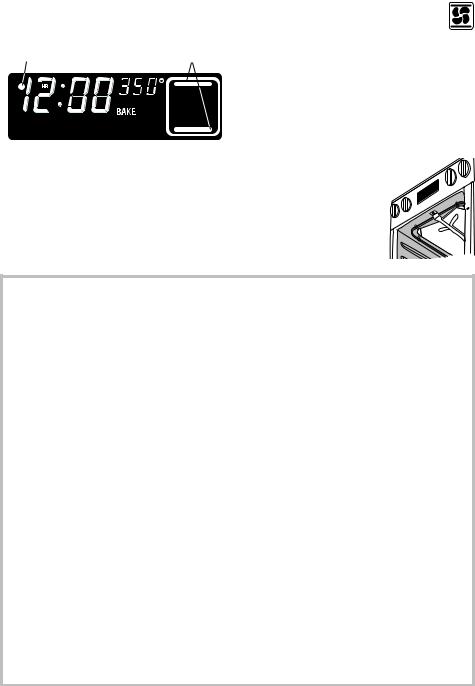
5.At the end of the set time, “END” will be displayed and two chimes will sound followed by one chime every 30 seconds for up to five minutes. Press the corresponding Timer pad to cancel the chimes.
NOTE: The Timer reminder chimes at the end of a set time may be changed. See Control Options (End-of-Timer Signal), page 13.
To Cancel a Set Time:
Press and hold the corresponding Timer pad for several seconds. After a slight delay the time of day will appear.
OR
Press the Timer pad and the “0” number pad. After a slight delay the timer will be canceled.
CANCEL PAD
Use to cancel all programming except the Clock and Timer functions.
AUTO SET PAD
Use with function pads to automatically set:
•350° F bake temperature
•325° F convect bake temperature (select models)
•hi or lo broil
•three hours of cleaning time
•140° F drying temperature (select models)
•160° F probe temperature (select models)
•170° F keep warm temperature (select models)
•quick or standard bread proofing (select models)
•to change control options
BAKE PAD
Use for baking and roasting.
1.Press Bake pad.
2.Press again for 350° F or press the Auto
Set pad. Each additional press of Auto Set will raise the temperature 25° F. Or,
press the appropriate number pads for the desired temperature between 100° F and 550° F.
3.When the oven turns on, a red preheat indicator will light and the bake icon will be displayed.
PREHEAT |
BAKE |
INDICATOR |
ICON |
4.A single chime will indicate the oven is preheated to the set temperature. The preheat indicator will turn off.
5.When cooking is complete, press Cancel pad. Remove food from oven.
CONVECT BAKE PAD (SELECT
MODELS)
1.Press Convect Bake pad.
2.Press again for 325° F or press the Auto
Set pad. Each additional press of Auto Set will raise the temperature 25° F. Or,
press the appropriate number pads for the desired temperature between 100° F and 550° F.
3.When the oven turns on, a red preheat
indicator will light and the convect icon will be displayed.
4.A single chime will indicate the oven is preheated to the set temperature. The preheat indicator will turn off.
5.When cooking is complete, press Cancel pad. Remove food from oven.
EVEN HEAT ASSIST
The range is equipped with a 110V electric top element to insure even browning during baking and roasting.
NOTES:
BAKING
• |
To recall the set temperature during |
|
with the convection fan at a low speed. |
|
|
preheat press the Bake pad. |
• |
As a general rule, when convection |
|
|
|
|||
• To change oven temperature during |
|
baking, set the oven temperature |
||
|
cooking, press the Bake pad and the |
|
25° F lower than the conventional |
|
|
appropriate number pads. |
|
recipe or prepared mix directions. |
|
• |
Allow 10-12 minutes for the oven to |
|
Baking time will be the same to a |
|
|
few minutes less than directions. |
|||
|
preheat. |
|
||
|
|
When roasting meat using the con- |
||
• |
Do not use temperatures below 140° F • |
|||
|
to keep food warm or below 200° F for |
|
vection setting, roasting times may |
|
|
cooking. For food safety reasons, lower |
|
be up to 30% less. (Maintain conven- |
|
|
|
tional roasting temperatures.) |
||
|
temperatures are not recommended. |
|
||
|
|
See chart in “Cooking Made Simple” |
||
• For additional baking and roasting tips, |
• |
|||
|
booklet for recommended roasting tem- |
|||
|
refer to the “CookingMadeSimple” |
|
||
|
|
perature and times, and additional baking |
||
|
booklet. |
|
||
|
|
and convection cooking tips. |
||
CONVECT BAKING |
|
|||
• |
The convection fan will stop when- |
|||
(select models) |
||||
|
ever the oven door is opened. |
|||
• |
Convect Bake function cycles both |
|
||
|
|
|||
the bake burner and broil element along
8

OVEN COOKING, CONT.
BROIL PAD
Use for top browning or broiling. For best results, use the broiler pan provided with your range.
1.Press the Broil pad.
2.Press the Auto Set pad for hi broil, press again for lo broil, or press the
appropriate number pads to set desired broil temperature between 300° and 550° F.
3.For optimal broiling, preheat three to four minutes.
4.Place food in oven. Close the oven door.
5.Follow broiling recommendations in
“Cooking Made Simple” booklet.
6.When broiling is complete, press Cancel pad. Remove food and broiler pan from oven.
COOK TIME/STOP TIME
PADS (CLOCK CONTROLLED
OVEN COOKING)
Use to program the oven to start and stop automatically. Cook time may be set for up to 11 hours and 59 minutes (11:59). The clock must be functioning and correctly set for this feature to work.
4.At the end of cook time, the oven will shut off automatically, END and COOK TIME will be displayed and three chimes will sound.
5.Press Cancel pad. Remove food from oven. If the program is not canceled, there will be two reminder chimes every minute for up to 30 minutes.
NOTE: The Cook Time/Stop Time reminder chimes may be changed. See Control Options (End-of-Cook-Time Signal), page 13.
TO DELAY THE START OF COOKING AND TURN OFF AUTOMATICALLY:
1.Press Cook Time pad. COOK TIME will flash. Press the appropriate number pads to enter cooking time in hours and minutes.
2.Press the Bake or Convect Bake (select models) pad and select the temperature. COOK TIME will be displayed along with the temperature.
3.Press Stop Time pad. Display shows when the oven will stop based on an immediate start.
4.Press Stop Time pad again. STOP
TIME must be flashing to set the delay start time.
5.Press the appropriate number pads to enter the time you want the oven to stop.
6.DELAY will be displayed.
7.At the end of the delay period, BAKE and COOK TIME will be displayed along with the temperature.
8.Follow steps 3-5 in preceding section.
KEEP WARM PAD (SELECT MODELS)
For safely keeping foods warm or for warming breads and plates.
1.Press Keep Warm pad.
2.Press Auto Set pad for 170° F or press
the appropriate number pads for temperatures between 145° and 190° F.
3.KEEP WARM and the temperature selected will be displayed when the function is active.
4.When warming is complete, press Cancel pad. Remove food from the oven.
See additional Keep Warm notes, page 10.
TO START IMMEDIATELY AND TURN OFF AUTOMATICALLY:
1.Press Cook Time pad. COOK TIME will flash. Press the appropriate number pads to enter cooking time in hours and minutes.
2.Press the Bake or Convect Bake (select models) pad and select the temperature. COOK TIME will be displayed along with the temperature.
3.One minute before the end of the programmed cook time, the oven light will turn on. The light will turn off automatically when Cancel pad is pressed or after oven door is opened and closed.
NOTES:
BROILING |
CLOCK CONTROLLED |
• Hi broil is used for most broiling. |
OVEN COOKING |
|
|
Use lo broil when broiling longer |
• Highly perishable foods such as dairy |
cooking foods to allow them to |
products, pork, poultry or seafood |
cook to well done stage without |
are not recommended for delayed |
excessive browning. |
cooking. |
• Never cover broiler pan insert with |
• Clock controlled baking is not recom- |
aluminum foil. This prevents fat from |
mended for baked items that require |
draining to the pan below. |
a preheated oven, such as cakes, cook- |
|
ies and breads. |
9

MEAT PROBE PAD
(SELECT MODELS)
To roast and bake items to the desired temperature without over or under cooking.
1.Insert the probe into the food item. (For meats, the probe tip should be located in the center of the thickest part of the meat and not into the fat or touching a bone.)
2.Insert the probe plug into the receptacle located on the top right of the oven. Be certain to insert plug into the receptacle all the way. The control will read PRESS PROBE PAD.
3.Press Probe Pad.
4.Set the desired internal temperature of the food by pressing Auto Set pad for
160° F or press the appropriate number pads for temperature between 100° and 185° F.
5.Press the Bake or Convect Bake
(select models) pad. Press the appropri-
ate number pads for the desired temperature between 100° and 550° F.
6.When the probe has reached the set temperature, the oven will shut off, “END” will be displayed and four chimes will sound followed by one chime every minute for one hour or until the Cancel pad is pressed.
BREAD PROOFING PAD
(SELECT MODELS)
For proofing or allowing yeast bread products to rise prior to baking. There are two proofing methods available – STANDARD and QUICK.
Standard Proofing temperature is slightly higher than room temperature, protecting dough from temperature changes and drafts that can affect proofing results.
Quick Proofing provides faster results than countertop or standard proofing, without harming the yeast.
1.Press Bread Proofing pad.
2.Press the Auto Set pad for Standard Proof, press again for Quick Proof.
3.When proofing is complete, press the
Cancel pad.
NOTES:
KEEP WARM
•For optimal food quality, oven cooked foods should be kept warm for no longer than 1 to 2 hours.
•For optimal food quality and color, foods cooked on the range top should be kept warm for an hour or less.
•To keep foods from drying, cover loosely with foil or a lid.
•TO WARM DINNER ROLLS:
-cover rolls loosely with foil and place in oven.
-press Keep Warm and Auto Set pads.
-warm for 12-15 minutes.
•TO WARM PLATES:
-place 2 stacks of up to four plates each in the oven.
-press Keep Warm and Auto Set pads.
-warm for five minutes, turn off the oven and leave plates in the oven for 15 minutes more.
-use only oven-safe plates, check with the manufacturer.
-do not set warm dishes on a cold surface as rapid temperature changes could cause crazing.
MEAT PROBE
•The probe must be removed from the oven when it is not being used.
•Because of the excellent insulation of the oven, the retained heat continues to cook the food after the signal has sounded and the oven has cycled off. For this reason it is important to remove the food from the oven as soon as the signal sounds.
•Use the handle of the probe for inserting and removing. Do not pull on the cable. Use a potholder to remove since probe becomes hot.
•For frozen meats, insert probe after 1-2 hours of roasting.
•To clean cooled probe, wipe with a soapy dishcloth. Do not submerge probe in water or wash in the dishwasher.
BREAD PROOFING
•For any dough that requires one rise, either Standard or Quick Proofing can be used.
•For dough requiring two rises, Standard Proofing must be used for the first rising period. Either Standard or Quick Proofing can be used for the second rise.
10

OVEN COOKING, CONT.
DRYING PAD
(SELECT MODELS)
For drying fruits, vegetables, herbs, etc. Use a drying rack for best results. It allows air to circulate evenly around the foods.
1.Press the Drying pad.
2.Press the Auto Set pad for 140° F or press the appropriate number pads for
the desired drying temperature between 100° and 200° F.
3.The oven door needs to be opened slightly to allow moisture to escape from the oven during the drying process.
•Open the oven door slightly.
•Place the magnetic door spacer
(Part No. 8010P146-60) over the plunger switch
at the upper right side of the oven frame.
The spacer provides a gap between the
oven frame and the oven door allowing moisture to escape.
•Gently close the door until the spacer magnet makes contact with the oven door. The magnet will hold the spacer in the proper position during the drying process and allows the door to be opened at any time during drying without losing proper positioning.
NOTES:
DRYING |
|
||
• |
To purchase a drying rack, contact |
• Fruits that turn brown when exposed |
|
|
your Jenn-Air dealer for the |
to air should be treated with an antioxi- |
|
|
“DRYINGRACK” Accessory Kit or |
dant. Try one of the following methods: |
|
|
call 1-800-688-8408. |
1. Dip fruit in a mixture of two parts |
|
• |
Most fruits and vegetables dry well |
||
bottled lemon juice to one part |
|||
|
and retain their color when dried at |
cool water. |
|
|
140° F. For optimal flavor, dry herbs |
2. Soak fruit in a solution of 1 tsp. |
|
|
at 100° F, however, at this lower |
ascorbic acid or commercial anti- |
|
|
temperature expect extended drying |
oxidant to 1 quart of cold water. |
|
|
times of up to 8 hours. |
||
|
• Foods may drip during the drying pro- |
||
• The length of drying times vary due to |
|||
cess. After drying high acid or sugary |
|||
|
the following: water and sugar con- |
||
|
foods, clean the oven bottom with soap |
||
|
tent of food, size of food pieces, |
||
|
and water. The porcelain oven finish |
||
|
amount of food being dried, humidity |
||
|
may discolor if acid or sugary food soils |
||
|
in the air. |
||
|
are not wiped up prior to high heat or |
||
• Check foods at the minimum drying |
|||
a self-cleaning cycle. |
|||
|
time. Dry longer if necessary. |
• Refer to other resources at your local |
|
• More than one rack of food may be |
|||
library or call your local County Exten- |
|||
|
dried at the same time. However, |
sion service for additional information. |
|
|
additional drying time is needed. |
|
|
NOTE: If the spacer is not placed correctly, the convection fan will not operate.
Follow the drying guide on page 12 for drying times. Cool foods to room temperature before testing for doneness.
4.When drying is complete, turn the oven off by pressing the Cancel pad. Using a potholder, remove the magnetic spacer.
NOTE: Please keep the magnetic spacer in a safe and convenient place for easy access. To replace, call 1-800-688-8408 to order Part No. 8010P146-60.
11

DRYING GUIDE
|
|
|
Approx. |
Fruits |
Varieties Best for Drying |
Preparation |
Drying Time Test for Doneness |
|
|
|
at 140°F ** |
Apples* |
Firm Varieties: Graven |
|
Stein, Granny Smith, |
|
Jonathan, Winesap, |
|
Rome Beauty, Newton. |
Apricots* |
Blenheim/Royal most |
|
common. Tilton also good. |
Bananas* |
Firm Varieties |
Cherries |
Lambert, Royal Ann, |
|
Napoleon, Van or Bing. |
Nectarines |
Freestone Varieties. |
and Peaches* |
|
Pears* |
Bartlett |
Pineapple |
Fresh or canned. |
Orange and Select rough-skinned fruit. Lemon Peel Do not dry the peel of fruit
marked “color added”.
Vegetables
Wash, peel if desired, core and slice |
4-8 hours |
Pliable to crisp. Dried |
into 1/8” slices. |
|
apples store best when |
|
|
they are slightly crisp. |
Wash, halve, and remove pits. |
18-24 hours |
Soft, pliable. |
Peel and cut into 1/4” slices. |
17-24 hours. |
Pliable to crisp. |
Wash and remove stems. Halve and |
18-24 hours. |
Pliable and leathery. |
remove pits. |
|
|
Halve and remove pits. Peeling is |
24-36 hours |
Pliable and leathery. |
optional but results in better-looking |
|
|
dried fruit. |
|
|
Peel, halve and core. |
24-36 hours |
Soft and pliable. |
Wash, peel and remove thorny eyes. |
Canned: |
Soft and pliable. |
Slice length wise and remove the small |
14-18 hours |
|
core. Cut crosswise into 1/2” slices. |
Fresh: |
|
|
12-16 hours |
|
Wash well. Thinly peel the outer 1/16 |
1-2 hours |
Tough to brittle. |
to 1/8” of the peel. Do not use the |
|
|
white bitter pith under the peel. |
|
|
Tomatoes |
Plum, Roma |
Halve, remove seeds. Place tomatoes |
12-18 hours |
Tough to crisp. |
|
|
skin side up on rack. Prick skins. |
|
|
Carrots |
Danvers Half Long, |
Do not use carrots with woody fiber or |
4-8 hours |
Tough to brittle. |
|
Imperator, Red Cored |
pithy core. Wash, trim tops and peel if |
|
|
|
Chantenay |
desired. Slice crosswise or diagonally |
|
|
|
|
in 1/4” slices. Steam blanch for 3 min. |
|
|
Hot Peppers |
Ancho, Anaheim |
Wash, halve and seed. Prick |
4-6 hours |
Pods should appear shriv- |
|
|
skin several times. |
|
eled, dark red and crisp. |
|
|
|
|
|
Herbs |
|
|
|
|
Parsley, Mint, |
|
Rinse in cold water. Leave stems on |
1-3 hours |
Brittle and crumbly. |
Cilantro, Sage, |
|
until leaves are dry, then discard. |
|
|
Oregano |
|
|
|
|
Basil |
|
Cut leaves 3 to 4” from top of plant |
2-5 hours |
Brittle and crumbly. |
|
|
just as buds appear. Rinse leaves in |
|
|
|
|
cold water. |
|
|
*Fruits requiring an antioxidant to prevent discoloration and loss of nutrients. Refer to the notes on page 11 for specific methods.
** 12 Hour Off will not occur during drying functions.
12

OVEN COOKING, CONT.
CONTROL OPTIONS
TO CHANGE FACTORY SET DEFAULT OPTIONS:
1.Press the Setup Options (0) pad and the desired option pad. (See Options below.)
2.Current option will appear in the display.
3.Press the Auto Set pad to change the option.
4.Press any function pad other than the Cancel pad to set the displayed option and exit the program.
OPTIONS AVAILABLE:
END-OF-TIMER SIGNAL
(TIMER 1 & TIMER 2)
There are three choices for the end of "timer" reminder signals.
•Two chimes (Timer 1) or four chimes (Timer 2) followed by one chime every 30 seconds for up to five minutes (default setting).
•Two chimes (Timer 1) or four chimes (Timer 2) followed by one chime every minute for up to 30 minutes.
•Two chimes (Timer 1) or four chimes (Timer 2) followed by no other chimes.
NOTE: The reminder signal chosen will apply to both timers.
CONTROL LOCK (1)
The function pads on the control can be locked to prevent unwanted use for safety and cleaning benefits.
Control Lock will not lock out the Timer, Clock or Oven Light.
12 HOUR OFF/SABBATH
MODE (2)
The oven may be set to turn off after 12 hours or stay on indefinitely. The default is set to turn off after 12 hours.
SOUND LEVEL (3)
The sound of the chimes may be changed with IIIIIIII(8) being the highest volume and I(1) being the lowest.
The default is set at level 6.
12/24 HOUR CLOCK (4)
The clock may be set for a 12-hour or 24-hour clock. The default is set for a 12hour clock.
SCROLL SPEED (5)
The scroll speed of the messages in the display may be changed from FAST to MEDIUM to SLOW. The default is set for the medium speed.
END-OF-COOK TIME SIGNAL (6)
There are three choices for the end of "clock controlled cooking" reminder signals.
•Three chimes followed by two chimes every minute for up to 30 minutes (default setting).
•Three chimes followed by no other chimes.
•Three chimes followed by two chimes every 30 seconds for up to five minutes.
TEMP C/F (7)
Thetemperaturescalemaybechanged to Centigrade or Fahrenheit. The default is set for Fahrenheit.
LANGUAGE (8)
The words which scroll in the display may be changed from English to French or Spanish.
DEFAULT (9)
The control can be reset to restore the factory setting for each option.
DISPLAY ON/OFF (CLOCK)
The time-of-day display may be shut off when the oven is not in a cooking or cleaning function.
13
OVEN TEMPERATURE
ADJUSTMENT
If you think the oven is operating too cold or hot, you can adjust it. Bake several test items and then adjust the temperature setting not more than 10° F at a time.
TO ADJUST:
1.Press the Bake pad and enter 550° F.
2.Press and hold the Bake pad for several seconds until TEMP ADJ is displayed.
3.Press the Auto Set pad - each press changes the temperature by 5° F. The control will accept changes from -35° to +35° F.
4.If the oven was previously adjusted, the change will be displayed. For example, if
the oven temperature was reduced by 15° F, the display will show -15° F.
5.When you have made the adjustment, press any function pad, OPTION CHANGED will scroll and the time of day will reappear in the display. The oven will now bake at the adjusted temperature.
NOTE: It is not recommended to adjust the temperature if only one or two recipes are in question.
OVEN LIGHT
The oven light automatically comes on when the door is opened. When the door is closed, press the Oven Light pad on the control panel to turn the light on or off.
The oven light will come on automatically one minute before the end of a clock controlled cooking operation.
OVEN BOTTOM
Protect oven bottom against spillovers, especially acidic or sugary spills, as they may discolor the porcelain enamel. Use the correct pan size to avoid spillovers and boilovers.
Do not place utensils or aluminum foil directly on the oven bottom.
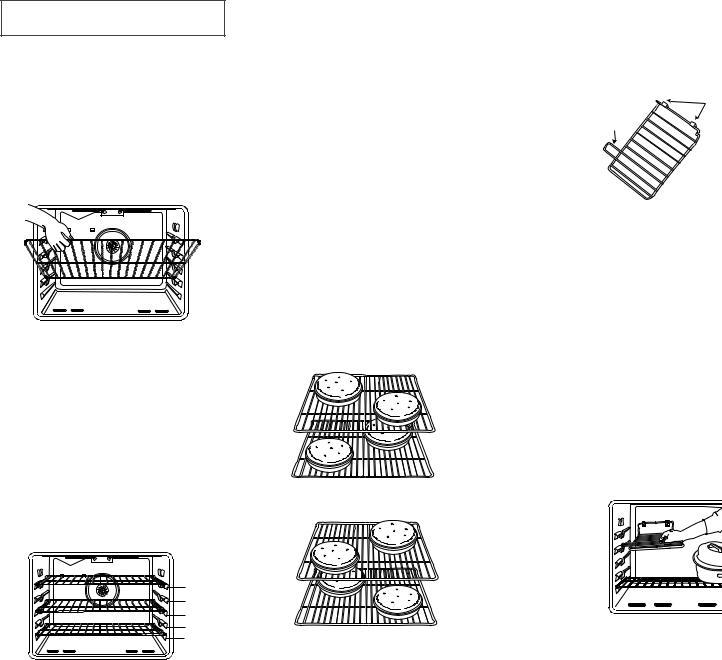
OVEN RACKS
The oven has two racks (three racks if convection). All racks are designed with a lock-stop edge.
TO REMOVE OVEN RACKS:
Pull rack straight out until it stops at the lock-stop position; lift up on the front of the rack and pull out.
TO REPLACE OVEN RACKS:
Place rack on the rack support in the oven; tilt the front end up slightly; slide rack back until it clears the lock-stop position; lower front and slide back into the oven.
Do not cover an entire rack with aluminum foil or place foil on the oven bottom. Baking results will be affected and damage may occur to the oven bottom.
RACK POSITIONS
5
4
3
2
1
Three-rack Convection
Baking (Racks 1, 3 and 5)
RACK 5:
Use for toasting bread or broiling very thin foods.
RACK 4:
Use for two-rack baking and for broiling.
RACK 3:
Use for most baked goods on a cookie sheet or jelly roll pan, layer cakes, fruit
pies, or frozen convenience foods, and for broiling.
RACK 2:
Use for roasting small cuts of meat, casseroles, baking loaves of bread, bundt cakes or custard pies, and two-rack baking.
RACK 1:
Use for roasting large cuts of meat and poultry, frozen pies, dessert souffles or angel food cake, and two-rack baking.
MULTIPLE RACK COOKING:
Two rack: Use rack positions 2 and 4, or 1 and 4. Stagger food to ensure proper air flow.
Layer Cake Placement (Conventional Oven) Bake on racks 2 and 4
Layer Cake Placement (Convection Oven) Convect Bake on racks 2 and 4
Threerack: (convection functions only, select models) Use rack positions 1, 3 and 5. See illustration at left.
HALF RACK
(SELECT MODELS) |
Tabs |
TO INSTALL Support |
|
IN OVEN: |
|
1.Always install half rack when
oven is cool. |
Front |
2.Grasp top center of the half rack. Align the side arm support between the top fourth and fifth oven rack guides. Insert the two tabs on the back frame of the half rack into the slots on the upper left rear of the oven wall.
3.Push firmly on the top surface of the half rack until the tabs slide into the slots and the half rack side arm support rests on the fourth oven rack guide.
4.Check for proper installation by placing your hand on the top surface of the half rack and pressing down firmly.
TO REMOVE FROM THE OVEN:
When the oven is cool, grasp the top center of the half rack and pull upward until the back tabs on the rack slide out of the oven back slots.
14
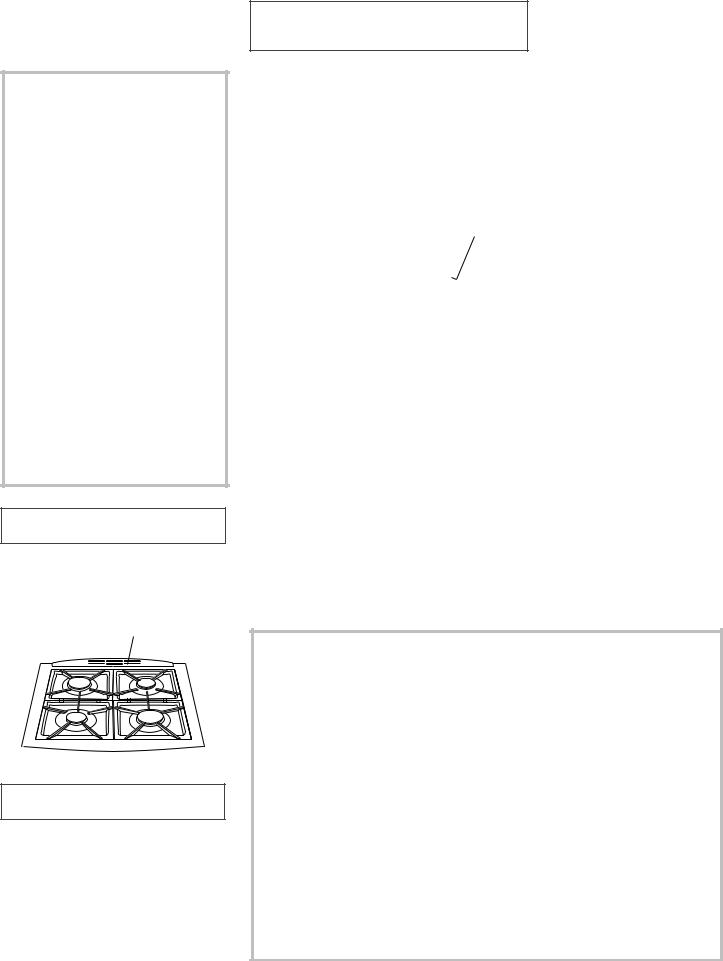
NOTES:
HALF RACK
•Do not use cookware that extends beyond edge of rack.
•For best results, allow two inches between the pan placed on the rack and the oven side wall.
•When opening the oven door, allow steam and hot air to escape before reaching into the oven to remove food.
•Use caution when removing items from the half rack to avoid burns.
•Carefully remove items from the lower rack to avoid disturbing the half rack.
•If not included with your range, contact your Jenn-Air dealer for the HALFRACK Accessory Kit or call 1-800-688-8408.
OVEN VENT
When the oven is in use, the area near the vent may become hot enough to cause burns. NEVER block the vent opening.
OVEN VENT LOCATION
COOLING FAN
The cooling fan will automatically turn on during cleaning and some baking operations. It is used to keep internal parts on the control panel cool. The fan will automatically turn off when parts have cooled. The fan may continue to operate after the oven has been turned off. This is normal.
CARE & CLEANING
CLEAN PAD
Use to set a self-clean cycle or a delayed selfclean cycle. One press of the Clean pad sets up an immediate clean cycle. A second press of the Clean pad sets up a delayed clean cycle.
•Clean oven frame, door frame (area
outside of gasket)
and around the opening in the door gasket with
a nonabrasive cleaner such as Bon Ami*. These areas are not exposed to cleaning temperatures.
•Remove oven racks. If racks are left in during a clean cycle, it may impair function and they will discolor. Turn off the oven light and close door.
* Brand names for cleaning products are registeredtrademarksoftherespectivemanufacturers.
4.When the clean cycle is complete, CLEANED will be displayed. LOC will remain on until the oven has cooled (approx. 1 hour).
5.When the oven is cool, LOC will no longer be displayed and the door may be opened.
6.Wipe out the oven interior with a damp cloth. If soil remains it indicates the cycle was not long enough.
TO CANCEL SELF-CLEAN:
1.Press Cancel pad.
2.If LOC is NOT displayed, open oven door. If LOC is displayed, allow oven to cool.
TO SET FOR DELAY START:
1.Press Clean pad twice.
2.Press the Auto Set pad to program a 2- hour delay. Each additional press of Auto Set will add 2 hours, up to a total delay of eight hours from the current time.
TO SET FOR IMMEDIATE START:
1.Press Clean pad once.
2.Press the Auto Set pad for 3 hours of cleaning time, press again for 4 hours and again if 2 hours of clean time is desired.
3.CLEANING and LOC plus the clean time will appear in the display.
3.The start time and the time of day will be displayed during the delay period.
4.At the end of the delay period, CLEANING, LOC and the clean time will appear in the display.
5.Follow steps 4-6 in preceding section.
NOTES:
• |
To prevent damage to oven door, do |
|
touching cooktop, door, window or oven |
|
not attempt to open oven door when |
|
vent area during a clean cycle. |
|
the LOC indicator word is displayed. |
• |
A cooling fan will automatically turn on |
• During the cleaning process, the kitchen |
|
during cleaning. If it does not operate, |
|
|
should be well ventilated to help elimi- |
|
contact an authorized servicer. |
|
nate normal odors associated with clean- |
• Wipe up sugary and acidic spillovers |
|
|
ing. Odors will lessen with use. |
|
such as sweet potatoes, tomato or milk- |
• |
It is normal for flare-ups, smoking or |
|
based sauces prior to a self-clean cycle. |
|
flaming to occur during cleaning if the |
|
Porcelain enamel is acid resistant, not |
|
oven is heavily soiled. It is better to |
|
acid proof and may discolor if spills are |
|
clean the oven regularly rather than to |
|
not wiped up before a self-clean cycle. |
|
wait until there is a heavy buildup of soil. |
• |
A white discoloration may appear after |
• |
Wipe up excess grease or spillovers to |
|
cleaning if acidic or sugary foods are not |
|
prevent smoke and flare-ups. |
|
wiped up before the clean cycle. This |
• |
It is normal for parts of the range to |
|
discoloration is normal and will NOT |
|
become hot during a clean cycle. Avoid |
|
affect performance. |
15

CLEANING PROCEDURES
 CAUTION
CAUTION
•Be sure appliance is off and all parts are cool before handling or cleaning. This is to avoid damage and possible burns.
•To prevent staining or discoloration, clean appliance after each use.
•If a part is removed, be sure it is correctly replaced.
BROILER PAN AND INSERT
•Place soapy cloth over insert and pan; let soak to loosen soil.
•Wash in warm soapy water. Use scouring pad to remove stubborn soil.
•Broiler pan and insert can be cleaned in dishwasher.
BURNER HEADS
•The surface burner heads are removable. The cap portion of the head is porcelain and the port area is aluminum. Wash the burner heads in the sink with mild detergent and a plastic scrubber.
•Check to be sure all ports are open. To open clogged ports, insert a straight pin directly into each port. Do not enlarge or distort the port.
•When replacing the burner heads, carefully align the tab on the burner base with the indentation in the head. The two pins will fit in the slots when the tab is aligned with the indentation.
NOTE: When burner heads are removed for cleaning, do not spill liquids through the
holes in the burner base.
BURNER HEAD
Cap 
 Ports
Ports
Port Area
 Indentation
Indentation
Slots Align
with Pins 
Ignitor

 Tab
Tab
BURNER BASE
BURNER GRATES
•Wash with warm, soapy water and a nonabrasive, plastic, scrubbing pad or in the dishwasher. For stubborn soils, clean with a soap–filled, nonabrasive, plastic pad or Cooktop Cleaning Creme* (Part # 20000001)** and a sponge.
•The grates are made of porcelain on cast iron and are very durable, however, they will gradually lose their shine and/or discolor. This is due to exposure to high temperatures from the gas flame.
CLOCK AND CONTROL
PAD AREA
•To activate “Control Lock” for cleaning, see page 13.
•Wipe with a damp cloth and dry.
•Glass cleaners may be used if sprayed on a cloth first. DO NOT spray directly on control pad and display area.
CONTROL PANEL
•Wipe with damp cloth.
•For stubborn soil, use mildly abrasive cleaning agents such as Bon Ami*. Do NOT use abrasive cleaners such as steel wool pads or oven cleaners. These products will permanently damage the surface.
CONTROL KNOBS
•Remove knobs in the OFF position by pulling forward.
•Wash, rinse and dry. Do not use abrasive cleaning agents as they may scratch the finish.
•Turn on each burner to be sure the knobs have been correctly replaced.
COOKTOP-PORCELAIN ENAMEL
Porcelain enamel is glass fused on metal and may crack or chip with misuse. It is acid resistant, not acid proof. All spillovers, especially acidic or sugary spillovers, should be wiped up immediately with a dry cloth.
16
•When cool, wash with soapy water, rinse and dry.
•Never wipe off a warm or hot surface with a damp cloth. This may cause cracking or chipping.
•Never use oven cleaners, abrasive or caustic cleaning agents on exterior finish of range.
DOOR HANDLE – PLASTIC
FINISHES
•When cool, clean with soap and water, rinse and dry.
•Use a glass cleaner and a soft cloth.
NOTE: Never use oven cleaners, abrasive or caustic liquid or powdered cleansers on plastic finishes. These cleaning agents will scratch or mar finish.
NOTE: To prevent staining or discoloration, wipe up fat, grease or acid (tomato, lemon, vinegar, milk, fruit juice, marinade) immediately with a dry paper towel.
OVEN WINDOW & DOOR –
GLASS
•Avoid using excessive amounts of water which may seep under or behind glass causing staining.
•Wash with soap and water. Rinse with clear water and dry. Glass cleaner can be used if sprayed on a cloth first.
•Do not use abrasive materials such as scouring pads, steel wool or powdered cleaners as they will scratch glass.
OVEN INTERIORS
•Follow instructions on page 15 to set a self-clean cycle.
OVEN RACKS
•Clean with soapy water.
•Remove stubborn soil with cleansing powder or soap-filled scouring pad. Rinse and dry.
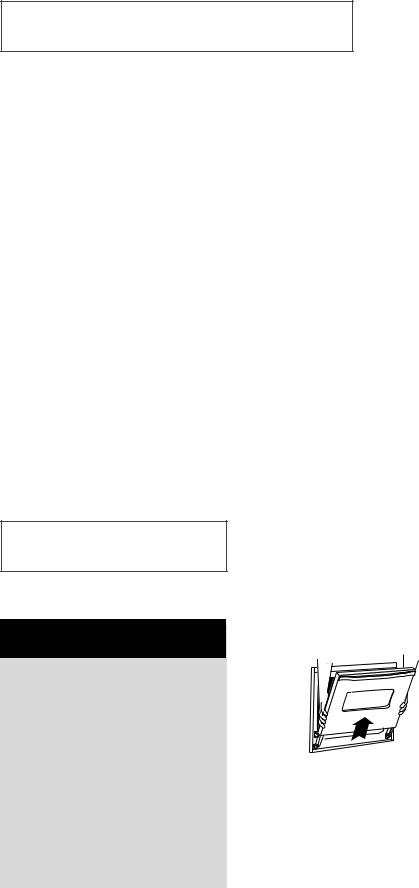
CARE & CLEANING, CONT.
•If over time, racks do not slide out easily, wipe the rack edge and rack support with a small amount of vegetable oil to restore ease of movement, then wipe off excess oil. Likewise, place one drop of vegetable oil on rack guides.
NOTE: Remove oven racks during a clean cycle. If racks are left in the oven, it may impair function and they will discolor.
STAINLESS STEEL
•DO NOT USE ANY CLEANING PRODUCT CONTAINING CHLORINE BLEACH.
•ALWAYS WIPE WITH THE GRAIN WHEN CLEANING.
•Daily Cleaning/Light Soil –– Wipe with one of the following - soapy water, white vinegar/water solution, Formula 409 Glass
and Surface Cleaner* or a similar glass cleaner - using a sponge or soft cloth. Rinse and dry. To polish and help prevent fingerprints, follow with Stainless Steel Magic Spray (Jenn-Air Model A912, Part No. 20000008)**.
•Moderate/Heavy Soil –– Wipe with one of the following - Bon Ami, Smart Cleanser, or Soft Scrub* - using a damp sponge or soft cloth. Rinse and dry. Stubborn soils may be removed with a damp Scotch-Brite* pad; rub evenly with the grain. Rinse and dry. To restore luster and remove streaks, follow with Stainless Steel Magic Spray.
•Discoloration –– Using a damp sponge or soft cloth, wipe with Cameo Stainless Steel Cleaner*. Rinse immediately and dry. To remove streaks and restore luster, follow with Stainless Steel Magic Spray.
STORAGE DRAWER – PAINTED
ENAMEL
•When cool, wash with warm soapy water, rinse and dry. Never wipe a warm or hot surface with a damp cloth as this may damage the surface and may cause a steam burn.
•For stubborn soil, use mildly abrasive cleaning agents such as baking soda paste or Bon Ami.* Do not use abrasive, caustic or harsh cleaning agents such as steel wool pads or oven cleaners. These products will scratch or permanently damage the surface.
NOTE: Use dry towel or cloth to wipe up spills, especially acidic or sugary spills. Surface may discolor or dull if soil is not immediately removed. This is especially important for white surfaces.
* Brand names for cleaning products are registered trademarks of the respective manufacturers. ** To order direct, call 1-800-688-8408.
MAINTENANCE
OVEN DOOR
 CAUTION
CAUTION
•NEVER place excessive weight on or stand on an open oven door. This could cause the range to tip over, break the door, or injure the user.
•NEVER attempt to open or close door or operate oven until door is properly replaced.
•NEVER place fingers between hinge and front oven frame. Hinge arms are spring mounted. If accidentally hit, the hinge will slam shut against oven frame and could injure your fingers.
TO REMOVE:
1.When cool, open the oven door to the first stop position (opened about four inches).
2.Grasp door at each side. Do not use the door handle to lift door.
3.Lift up evenly until door clears hinge
arms.
TO REPLACE:
1.Grasp door at each side.
2.Align slots in the door with the hinge arms on the range.
3.Slide the door down onto the hinge arms until the door is completely seated on the hinges. Push down on the top corners of the door to completely seat door on hinges. Door should not appear crooked.
17
NOTE: The oven door on a new range may feel “spongy” when it is closed. This is normal and will decrease with use.
OVEN WINDOW
TO PROTECT THE OVEN DOOR WINDOW:
1.Do not use abrasive cleaning agents such as steel wool scouring pads or powdered cleaners as they may scratch the glass.
2.Do not hit the glass with pots, pans, furniture, toys, or other objects.
3.Do not close the oven door until the oven racks are in place.
Scratching, hitting, jarring or stressing the glass may weaken its structure causing an increased risk of breakage at a later date.
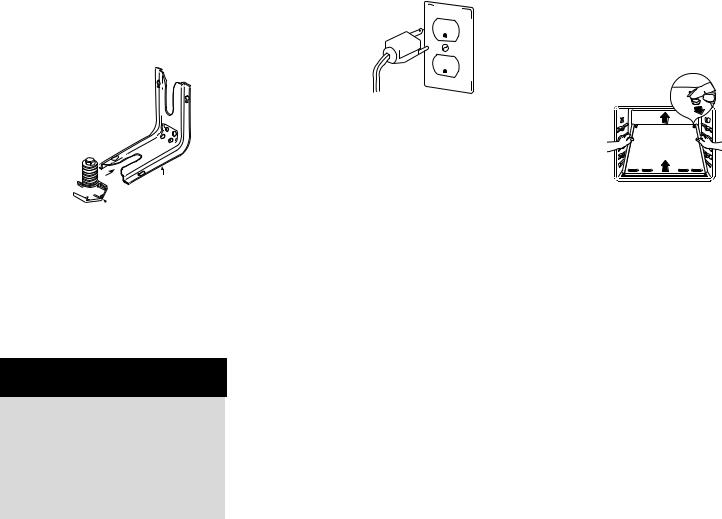
LEVELING LEGS
• Be sure the anti-tip bracket secures one of the rear leveling legs to the floor. This bracket prevents the range from accidentally tipping.
The range should be lev- |
|
|
eled when installed. If the |
|
|
range is not level, turn the |
|
|
plastic leveling legs, lo- |
|
|
cated at each cor- |
|
|
ner of |
the |
|
range, |
until |
ANTI- IP-TIPBRACKEBRACKET |
range is level. 


 LEVELING LEG
LEVELING LEG
LEVELING LEG
OVEN LIGHT
To assure the proper replacement bulb is used, order bulb from Maytag Customer Service. Call 1-800-688-8408, ask for part number 74004458 - halogen bulb.
 CAUTION
CAUTION
•Disconnect power to range before replacing light bulb.
•Allow oven to cool before replacing light bulb.
•Make sure bulb cover and bulb are cool before touching.
TO REPLACE OVEN LIGHT BULB:
1.When oven is cool, use fingertips to grasp edge of bulb cover. Pull out and remove.
2.Carefully remove old bulb by pulling straight out of ceramic base.
3.To avoid damaging or decreasing the life of the new bulb, do not touch the bulb with bare hands or fingers. Hold with a cloth or paper towel. Push new bulb prongs straight into small holes of ceramic base.
4.Replace bulb cover by snapping into place.
5.Reconnect power to the range. Reset clock.
ELECTRICAL
CONNECTION
Appliances which 
 require electrical
require electrical 
 powerareequipped
powerareequipped 

 with a three-prong
with a three-prong
grounding plug
which must be plugged directly into a properly grounded three-hole 120 volt electrical outlet.
Always disconnect power to appliance before servicing.
The three-prong grounding plug offers protection against shock hazards. DO NOT
CUT OR REMOVE THE THIRD GROUNDING PRONG FROM THE POWER CORD PLUG.
If an ungrounded, two-hole or other type electrical outlet is encountered, it is the personal responsibility of the appliance owner to have the outlet replaced with a properly grounded three-hole electrical outlet.
STORAGE DRAWER
The storage drawer at the bottom of the range is safe and convenient for storing metal and glass cookware. DO NOT store plastic, paperware, food or flammable material in this drawer. Remove drawer to clean under range.
TO REMOVE: Empty drawer then pull out to the first stop position. Lift up front of drawer and pull to the second stop position. Grasp sides and lift up and out to remove drawer.
TO REPLACE: Fit the ends of the drawer glides onto the rails. Lift up drawer front and gently push in to first stop position. Lift up and continue to slide drawer to the closed position.
OVEN BOTTOM
The oven bottom on a conventional bake range may be removed for easier cleaning.
NOTE: The oven bottom on convection models is not removable.
TO REMOVE: When cool, remove the oven racks. Slide the
two catches, lo- |
2 |
|
1 |
cated at each rear |
|
corner of the oven |
|
bottom, toward the |
3 |
front of the oven. |
|
Lift the rear edge of the oven bottom slightly, then slide it back until the front edge of the oven bottom clears the oven front frame. Remove oven bottom from oven.
TO REPLACE: Fit the front edge of the oven bottom into the oven front frame. Lower the rear of the oven bottom and slide the two catches back to lock the oven bottom in place.
REMOVAL OF GAS
APPLIANCE
Gas appliance connectors used to connect this appliance to the gas supply are not designed for continuous movement. Once installed, DO NOT repeatedly move this gas appliance for cleaning or to relocate. If this appliance has to be moved and/or removed for servicing, follow the procedure described in the installation instructions. For information, contact Maytag Customer Service at 1-800-688-1100.
To prevent range from accidentally tipping, range must be secured to the floor by sliding rear leveling leg into the anti-tip bracket.
18

BEFORE YOU CALL FOR SERVICE
FOR MOST CONCERNS, TRY
THESE FIRST:
•Check if oven controls have been properly set.
•Check to be sure plug is securely inserted into receptacle.
•Check or re-set circuit breaker. Check or replace fuse.
•Check power supply.
•Aluminum foil was incorrectly used. Never line the broiler insert with foil.
•Trim excess fat from meat before broiling.
•A soiled broiler pan was used.
OVEN WILL NOT SELF-CLEAN.
•Check to make sure the cycle is not set for a delayed start. See pg. 15.
•Check if door is closed.
PART OR ALL OF APPLIANCE DOES
NOT WORK.
•Check if surface and/or oven controls have been properly set. See pgs. 5 & 7.
•Check if oven door is unlocked after selfclean cycle. See pg. 15.
•Check if oven is set for a delayed cook or clean program. See pgs. 9 & 15.
•Check if Control Lock is activated. See pg. 13.
BAKING RESULTS ARE NOT AS EXPECTED OR DIFFER FROM PREVIOUS OVEN.
•Make sure the oven vent has not been blocked. See pg. 15 for location.
•Check to make sure range is level.
•Temperatures often vary between a new oven and an old one. As ovens age, the oven temperature often “drifts” and may become hotter or cooler. See pg. 13 for instructions on adjusting the oven temperature. NOTE: It is not recommended to adjust the temperature if only one or two recipes are in question.
•Check that oven temperature is decreased by 25° F when convect baking.
•See “Cooking Made Simple” booklet for more information on bakeware and baking.
•Make sure oven is preheated when recipe or directions recommend preheat.
•Check rack positions. See page 14.
FOOD IS NOT BROILING PRO-
PERLY OR SMOKES EXCESSIVELY.
OVEN DID NOT CLEAN PROPERLY.
•Longer cleaning time may be needed.
•Excessive spillovers, especially sugary and/ or acidic foods, were not removed prior to the self-clean cycle.
OVEN DOOR WILL NOT UNLOCK
AFTER SELF-CLEAN CYCLE.
•Oven interior is still hot. Allow about one hour for the oven to cool after the completion of a self-clean cycle. The door can be opened when the LOC indicator word is not displayed.
MOISTURE COLLECTS ON OVEN WINDOW OR STEAM COMES FROM OVEN VENT.
•This is normal when cooking foods high in moisture.
•Excessive moisture was used when cleaning the window.
SURFACE BURNER FAILS TO
LIGHT.
•Check to be sure burner ports or ignition ports are not clogged. See page 16.
•Check to be sure ignitor is dry and clicking. Burner will not light if ignitor is damaged, soiled or wet. If ignitor doesn’t click, turn control knob OFF.
SURFACE BURNER FLAME LIFTS
OFF PORTS.
•Check to be sure a pan is sitting on the grate above.
•Contact an authorized Jenn-Air servicer.
THE FLAME IS UNEVEN.
• Burner ports may be clogged.
SURFACE BURNER FLAME IS
YELLOW IN COLOR.
•Contact an authorized Jenn-Air servicer.
•Some yellow tips on the flame are acceptable when using LP gas.
THERE IS A STRONG ODOR OR
LIGHT SMOKE WHEN OVEN IS TURNED ON.
•This is normal for a new range and will disappear after a few uses. Initiating a clean cycle will “burn off” the odors more quickly.
•Turning on a ventilation fan will help remove the smoke and/or odor.
•Excessive food soils on the oven bottom. Use a self-clean cycle.
A FAN SOUND CAN BE HEARD
•This is the cooling fan and is normal. The fan will continue to run after use until the oven cools.
“F” PLUS A NUMBER AND THE MESSAGE: “CALL AN AUTHO- RIZED SERVICER OR 800-688- 1100.”
•This is called a fault code. If a fault code appears in the display and beeps sound, press the Cancel pad. If the fault code and beeps continue, disconnect power to the appliance. Wait a few minutes, then reconnect power. If fault code and beeps still continue, disconnect power to the appliance and call an authorized servicer.
•If the oven is heavily soiled, excessive flare-ups may result in a fault code during a clean cycle. Press Cancel pad and allow the oven to cool completely, wipe out excess soil, then reset the clean cycle. If the fault code and beeps still continue, disconnect power to the appliance and call an authorized servicer.
• Check oven rack positions. Food may be
too close to flame.
19
